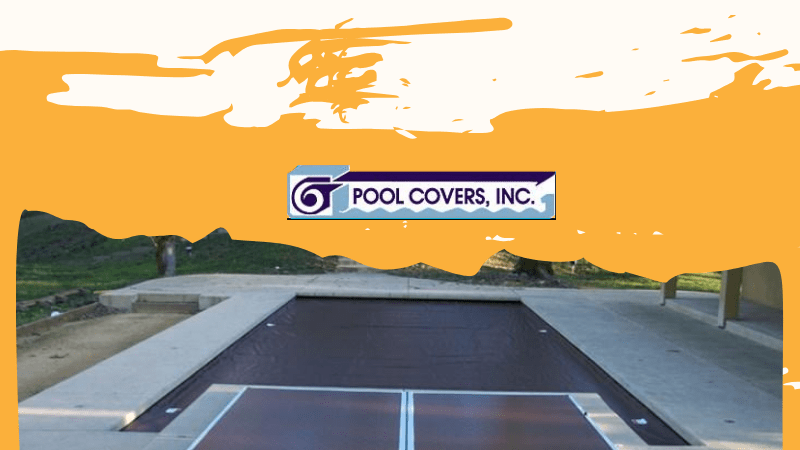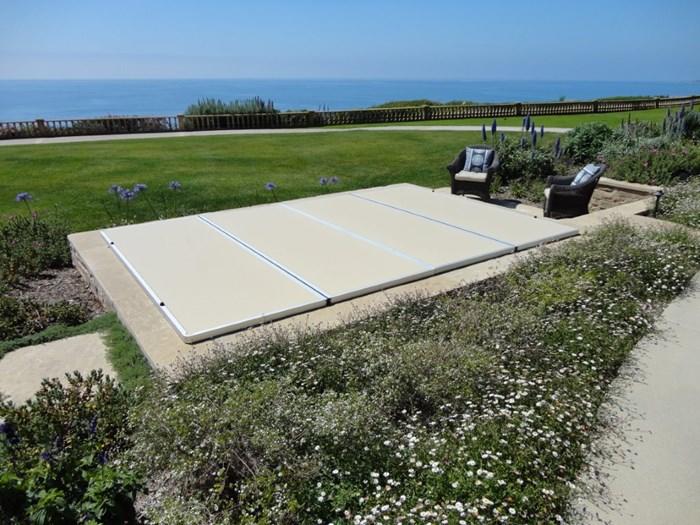
There are many safety pool covers for San Jose backyard pools. However, it’s important to know what you want in a cover to get one of good quality.
What is a safety pool cover?
A safety pool cover is a durable cover specifically designed to prevent accidental falls into the pool. It provides an essential layer of protection for households with children, pets, or even wildlife. Unlike regular pool covers, which primarily keep debris out, safety pool covers are engineered to support weight, making them robust enough to withstand people or animals stepping on them.
They are typically made from strong materials like heavy-duty mesh or solid vinyl and are secured to the pool deck with anchors and springs, creating a tight and secure fit.
Safety pool covers are classified by material (solid and mesh) and mechanism (manual and automatic), which will be discussed in this article.
ASTM standards for safety pool covers
The ASTM standards for safety pool covers are established by the American Society for Testing and Materials (ASTM) to ensure pool covers provide adequate safety to prevent accidental drowning, especially for children and pets. The key requirements for a pool cover to be certified as a safety cover (ASTM F1346-91) include:
1. Strength and weight-bearing capacity
Covers must support at least 485 pounds to withstand the combined weight of two adults and one child in an emergency.
2. Openings and gaps
Safety covers must not have openings large enough for a child’s head or body to pass through (less than 4 inches) to prevent entrapment or accidental entry.
3. Secure anchoring and installation
The cover must be securely anchored to prevent lifting or shifting, which could compromise safety. This includes both in-ground and above-ground cover installation methods.
4. Drainage
Covers must have adequate drainage to prevent dangerous water accumulation on top, either by allowing water to pass through (in the case of mesh covers) or by providing a means to remove water (for solid covers).
5. Labeling and warnings
Covers should have clear labels and warnings indicating that they meet ASTM safety standards and are designed to prevent accidental access.
Meeting these standards ensures that the pool cover effectively protects against accidental access, significantly reducing drowning risks.
Safety pool covers by material

Solid or mesh? Learn the types of safety pool covers by material to determine which suits your needs.
Solid safety covers
Solid safety covers are made of vinyl or similar waterproof materials. They prevent any debris, water, or sunlight from entering the pool. They block UV rays, reduce algae growth, and help maintain water chemistry.
- Pros: They keep debris and water out, reduce chemical loss, and provide safety.
- Cons: They require a pump to drain excess water from the top, as rain and melting snow can accumulate.
Mesh safety covers
Mesh safety covers are constructed from durable, woven mesh fabric. They allow water to drain through while keeping debris out.
- Pros: Easier maintenance as rainwater drains through reduces the need for a pump.
- Cons: They allow some sunlight and smaller debris, which may encourage algae growth over time.
Safety pool covers by mechanism
Do you want the economical manual safety covers or the convenience of automatic safety pool covers? Here are the types of pool cover by mechanism:
Manual safety covers
They are covers that require physical effort to operate. They are secured with snap-down anchors or slide along a track manually, providing safety and debris protection at an affordable price but needing more effort to cover or uncover.
There are two types of manual safety covers:
Snap-down manual:
- These covers are attached to the pool deck using snap-down anchors or fasteners that must be manually secured and released.
- Pros: They are affordable and effective for safety; they are easy to store when not in use.
- Cons: They take more effort to cover and uncover; they may not be ideal for frequent usage.
Track manual:
- These covers use a built-in track along the pool perimeter, allowing the cover to slide in and out manually. They can be upgraded to automatic covers.
- Pros: They provide a more secure fit, straightforward to operate.
- Cons: They can be costlier than snap-down and require manual effort to slide the cover in and out.
Automatic safety covers
These covers are motorized, either electric or hydraulic, and operate with the push of a button. They offer quick, hands-free protection, ideal for frequent use, though they come with higher installation and maintenance costs.
Electric automatic covers
These covers are run by an electric motor. They open and close with the flip of a switch or push of a button and typically run along a track installed along the pool’s edge.
- Pros: Convenient, fast, and ideal for regular use; offers a tight, secure fit.
- Cons: Higher upfront cost, requires electricity, and periodic maintenance for the motor.
Hydraulic automatic covers
These covers are powered by a hydraulic pump. They also operate along tracks and open or close with minimal effort.
- Pros: They are often more powerful than electric motors, reliable in various weather conditions, and particularly beneficial for larger pools.
- Cons: High installation and maintenance costs, as hydraulic systems require specialized parts and servicing.
These categories help guide the choice of safety pool cover based on your needs for protection, ease of use, and budget.
Benefits of safety pool cover
A safety pool cover provides several key benefits:
- Enhanced safety: Safety pool covers are designed to support the weight of a person or pet, reducing the risk of accidental falls into the pool, thus making them ideal for families with children or pets.
- Debris protection: These covers help keep leaves, dirt, and other debris out of the pool, which minimizes cleaning time and reduces the need for additional pool maintenance.
- Reduced water evaporation: A safety cover, especially the solid type, limits water evaporation, helping to maintain water levels and reduce the frequency of refills, conserving water and lowering utility costs.
- Chemical preservation: Safety covers help retain pool chemicals by limiting UV exposure and blocking debris, which leads to less frequent chemical balancing and cost savings on pool supplies.
- Energy efficiency: In colder months, safety covers provide some insulation, helping maintain water temperature and reducing the need for pool heating.
Safety pool covers for San Jose pool owners offer peace of mind, convenience, and cost savings in pool upkeep. Investing in a quality safety pool cover – and having a professional to work on the installation – ensures you enjoy these benefits.
For free consultation and estimate, call our Pool Covers, Inc. team at 707-864-6674 or email us at customerservice@poolcoversinc.com.









